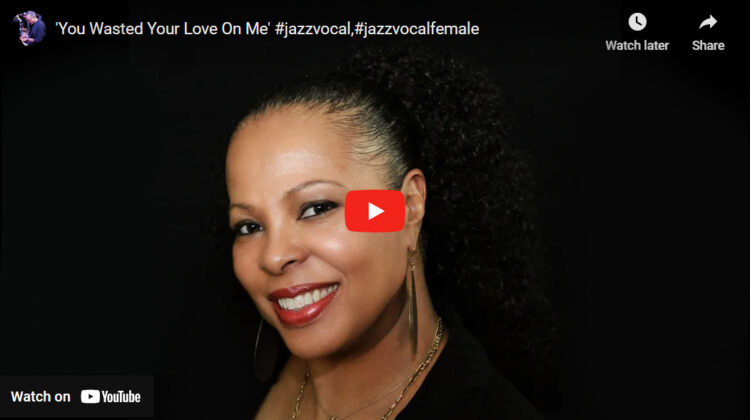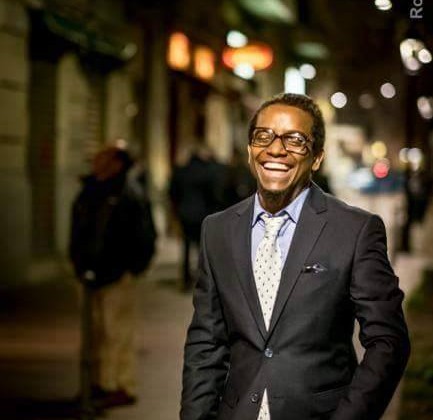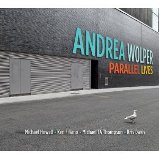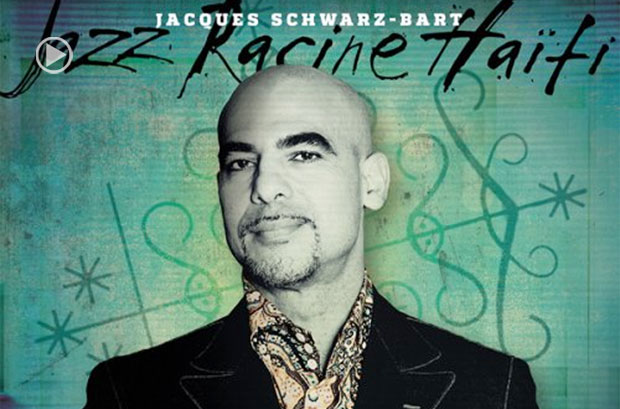By John Stevenson Combining the often separate worlds of jazz and Haitian vodun (or voodoo) music is at first glance a strange and unique pairing. There was a Black Haitian presence in New Orleans from 1792 right through to the Haitian revolution of 1804 and its aftermath and Haitians of African descent brought their religious and cultural practices to the Crescent City and its environs in Louisiana. The great jazz pianist Jelly Roll Morton was noted to have blamed voodoo for a protracted illness he was suffering from and references to voodoo have been present in jazz and related forms of music from Louisiana for more than a century. On arguably one of 2014’s most memorable recordings, Guadeloupean saxophonist Jacques Schwarz-Bart, brought together jazz improvisation and sacred voodoo rhythms on ‘Jazz Racine Haiti’. It’s a landmark album. It also served to look with a new lens on a cultural and religious practice which has otherwise been viewed in less than complimentary ways.  Built around a core group comprising vodun priests, vocalist Erol Josué, percussionist Gaston “Bonga” Jean-Baptiste, other vocalists Rozna Zila and Stephanie McKay, bassist Ben Williams, trumpeter Etienne Charles, pianists Milan Milanovic and Gregory Privat, drummer Obed Calvaire and bassist Reggie Washington – the album embodies jazz and Jacques’s act of aesthetic syncretism. ‘Kouzin’, the album’s incantatory and powerful opener is introduced by Josue’s plaintive chant. The interplay between Josué, Charles and Schwarz-Bart is particularly impressive as is the balance struck between improvisation and liturgical expression. It is masterly conceived and executed. I caught up with Jacques who filled me in on how he put ‘Jazz Racine Haiti’ (JRH) together and other insights into the spirituality surrounding the music: John Stevenson: What was the inspiration for JRH? Jacques Schwarz-Bart: The seed for the CD was planted in my heart at birth. My mother (critically acclaimed Guadeloupean novelist and poet Simone Schwarz-Bart) used to sing voodoo chants to me throughout my childhood. So it nourished my soul just as breast milk did my body. As I became more cognizant of jazz, classical and various forms of African music, I was able to appreciate what a gem those voodoo chants really were, both in their sophistication and their mystical charge. However, the urge to explore the Haitian voodoo tradition as a foundation for my jazz expression came much later in Morrocco. I was invited as a guest artist by the great Karim Ziad to perform with Gnaoua masters at the Essaouira Gnaoua Festival. After the concert, the Gnaoua priest, Hamid El Kasri told me he saw in me the same spirits in the Gnaoua people. He invited me to a purification ceremony in Rabat the very next day. I sat next to him for twelve hours, physically paralysed, while my mind seemed to be traveling through space and time at tremendous speed. And when I finally stood up, I felt a change had taken place in my being at a molecular level. On the plane back to New York City, the energy of the voodoo chants that I heard as a child came rushing in me like a fire ball. And then I knew I had to go through with Jazz Racine Haiti.
Built around a core group comprising vodun priests, vocalist Erol Josué, percussionist Gaston “Bonga” Jean-Baptiste, other vocalists Rozna Zila and Stephanie McKay, bassist Ben Williams, trumpeter Etienne Charles, pianists Milan Milanovic and Gregory Privat, drummer Obed Calvaire and bassist Reggie Washington – the album embodies jazz and Jacques’s act of aesthetic syncretism. ‘Kouzin’, the album’s incantatory and powerful opener is introduced by Josue’s plaintive chant. The interplay between Josué, Charles and Schwarz-Bart is particularly impressive as is the balance struck between improvisation and liturgical expression. It is masterly conceived and executed. I caught up with Jacques who filled me in on how he put ‘Jazz Racine Haiti’ (JRH) together and other insights into the spirituality surrounding the music: John Stevenson: What was the inspiration for JRH? Jacques Schwarz-Bart: The seed for the CD was planted in my heart at birth. My mother (critically acclaimed Guadeloupean novelist and poet Simone Schwarz-Bart) used to sing voodoo chants to me throughout my childhood. So it nourished my soul just as breast milk did my body. As I became more cognizant of jazz, classical and various forms of African music, I was able to appreciate what a gem those voodoo chants really were, both in their sophistication and their mystical charge. However, the urge to explore the Haitian voodoo tradition as a foundation for my jazz expression came much later in Morrocco. I was invited as a guest artist by the great Karim Ziad to perform with Gnaoua masters at the Essaouira Gnaoua Festival. After the concert, the Gnaoua priest, Hamid El Kasri told me he saw in me the same spirits in the Gnaoua people. He invited me to a purification ceremony in Rabat the very next day. I sat next to him for twelve hours, physically paralysed, while my mind seemed to be traveling through space and time at tremendous speed. And when I finally stood up, I felt a change had taken place in my being at a molecular level. On the plane back to New York City, the energy of the voodoo chants that I heard as a child came rushing in me like a fire ball. And then I knew I had to go through with Jazz Racine Haiti.
 JS: There is a lot of commonality between Haitian, Martiniquan, Guadeloupean and French Guyanese music and even more interconnection between the music of the wider Dutch, Spanish and English speaking Caribbean. Yet a sense of division persists to this day. How has your music succeeded in breaking down the barriers erected by several hundred years of colonialism?
JS: There is a lot of commonality between Haitian, Martiniquan, Guadeloupean and French Guyanese music and even more interconnection between the music of the wider Dutch, Spanish and English speaking Caribbean. Yet a sense of division persists to this day. How has your music succeeded in breaking down the barriers erected by several hundred years of colonialism?
J S-B: I think voodoo music is the foundation for all musical styles that came out of the Americas. So when any person from the African diaspora hears this music, especially if it’s expressed through the universal language of jazz, the connection is instant, like the tie between the trunk and the roots. Exposing these roots creates an instant sense of unity throughout the Americas, and in particular in all people from the Caribbean. JS: How does this work resemble and differ from your other solo projects such as Sone Ka La?  J S-B: In Sone Ka La, I created all the melodies from A to Z, and in the few songs featured, the lyrics are of a secular nature. Whereas in JRH, I quoted rituals chants verbatim, staying true to the melodies and sacred lyrics. The arrangements around it are made in such a way as to naturally use the ritual chants as an extension of a composition or as launching pad for a composition. So it’s a delicate exercise of turning two worlds into a continuum of sounds that tell the same story. In the end, I feel that the mystical charge of voodoo music is made for a more poignant statement overall. JS: Erol Josué always sings with genuine passion and pain. In him we hear the spirit of voodoo stretching back to St Domingue and even further possibly to ancestral prayer grounds in Dahomey. How important is his voice to your jazz project? J S-B: Erol was the very first voice that I ever considered for this project. I consider a real inspiration! If it wasn’t for him, I wouldn’t have engaged in it. I needed a golden voice and he was that voice. He was the only singer in the band for an entire year until his own career made him less available, at which point I met Rozna who is incredible, and finally Moonlight Benjamin, who has now become the torch bearer of the project. Too bad I didn’t meet her before: she would be abundantly featured on the recording! But she will definitely be part of the next one! JS: How do audiences in the US respond to this intriguing melange of jazz improvisation and Haitian music? J S-B: First of all, Haitian music is a vast dipper, and most Haitian popular music doesn’t use that mix of highly sophisticated structures and melodies found in Haitian voodoo chants, not even mentioning the difference in the message. So I like to be specific and mention Haitian ritual voodoo chants rather than Haitian music. As far as American audiences, they are just as receptive as others around the globe. I’ve rarely been part of a project that leveraged such a consistent level of enthusiasm and support. JS: What is the significance of compositions such as ‘Legba Nan Bayè’, ‘Bade Zile’ and ‘Zepole’? J S-B: ‘Legba Nan Bayè’ describes the role of the spirit called Legba: he controls the gate between men and spirits. No ceremony can start unless he is called upon to open that gate and protects the other spirits from the sun as they come in the temple. ‘Bade Zile’ is written exclusively in sacred language only spoken by the priests. It calls upon the spirits of thunder and lighting, to empower men with boundless energy and clear their minds. ‘Vaudou Zepole’ is calling upon the spirit of Damballah: he is the creator of all life. He represents science, medicine and wisdom. This song welcomes him and his wife, ‘Ayda Wedo’ in the ceremony circle. The way I treated this song, I made it a tribute to the spirit of the wind, ‘Papa Loko’, hence the phrase passed between sax and trumpet, that mimics the fluid and rolling movement of the Alizee breeze that blows throughout the Caribbean. JS: Etienne Charles’s trumpet acts as the perfect foil for your saxophone on the recording. How long have you been collaborating with him and what makes his accompaniment so vital to this project? J S-B: Etienne is the trumpet player closest to me. We are both accomplished jazz musicians with strong knowledge of Afro-Caribbean music. We both have acute ears that allow us to communicate instantaneously with no explanation. That makes us two peas in a pod, a true unit. In addition, he is a great writer and arranger and someone I can always lean on for advice during a creative process. We have collaborated now on three CDs together: his last three and my last one, JRH. I love him dearly. JS: Do you plan to record and tour in the future? J S-B: We are in the middle of a series of your that will spread all the way till the end of 2015. Two other projects will stem from this one. A voodoo jazz trio that is currently performing already, made of voice, sax and voodoo drum. It is a very different sound from JRH with no harmonic instruments and less solo improvisation. The bulk of it is the interaction between two voices – the singer and the sax, while interpreting ritual voodoo chants. The other project is a large combo and involves different kinds of voodoo traditions. JS: Who are your main musical influences? J S-B: John Coltrane still makes me cry after all these years; Miles makes me feel the mystery of the universe. Wayne Shorter helps me see beauty in all manifestations of life. Toninho Horta helps me see the world in color. Milton Nascimiento helps me connect the opposite ends of the infinite continuum, and contemplate my life and death with no sorrow. And voodoo music gives me the energy to seek, create and play. JS: Do you think your music assists in shedding a more positive light on the musical talent available in Haiti and its diaspora? J S-B: I think my music helps people realize that voodoo chants are the musical pearl of the Americas, they really are our Afro-Caribbean opera! And yet it’s probably the least known tradition of all. My music also helps shed a positive light on voodoo spirituality: it is really about creating harmony within by connecting your thoughts, words and actions, and without, by respecting and honoring others, as well as your entire environment. It’s actually very close to Buddhism, and helps me daily in my involvement with others and my personal musical quest.
J S-B: In Sone Ka La, I created all the melodies from A to Z, and in the few songs featured, the lyrics are of a secular nature. Whereas in JRH, I quoted rituals chants verbatim, staying true to the melodies and sacred lyrics. The arrangements around it are made in such a way as to naturally use the ritual chants as an extension of a composition or as launching pad for a composition. So it’s a delicate exercise of turning two worlds into a continuum of sounds that tell the same story. In the end, I feel that the mystical charge of voodoo music is made for a more poignant statement overall. JS: Erol Josué always sings with genuine passion and pain. In him we hear the spirit of voodoo stretching back to St Domingue and even further possibly to ancestral prayer grounds in Dahomey. How important is his voice to your jazz project? J S-B: Erol was the very first voice that I ever considered for this project. I consider a real inspiration! If it wasn’t for him, I wouldn’t have engaged in it. I needed a golden voice and he was that voice. He was the only singer in the band for an entire year until his own career made him less available, at which point I met Rozna who is incredible, and finally Moonlight Benjamin, who has now become the torch bearer of the project. Too bad I didn’t meet her before: she would be abundantly featured on the recording! But she will definitely be part of the next one! JS: How do audiences in the US respond to this intriguing melange of jazz improvisation and Haitian music? J S-B: First of all, Haitian music is a vast dipper, and most Haitian popular music doesn’t use that mix of highly sophisticated structures and melodies found in Haitian voodoo chants, not even mentioning the difference in the message. So I like to be specific and mention Haitian ritual voodoo chants rather than Haitian music. As far as American audiences, they are just as receptive as others around the globe. I’ve rarely been part of a project that leveraged such a consistent level of enthusiasm and support. JS: What is the significance of compositions such as ‘Legba Nan Bayè’, ‘Bade Zile’ and ‘Zepole’? J S-B: ‘Legba Nan Bayè’ describes the role of the spirit called Legba: he controls the gate between men and spirits. No ceremony can start unless he is called upon to open that gate and protects the other spirits from the sun as they come in the temple. ‘Bade Zile’ is written exclusively in sacred language only spoken by the priests. It calls upon the spirits of thunder and lighting, to empower men with boundless energy and clear their minds. ‘Vaudou Zepole’ is calling upon the spirit of Damballah: he is the creator of all life. He represents science, medicine and wisdom. This song welcomes him and his wife, ‘Ayda Wedo’ in the ceremony circle. The way I treated this song, I made it a tribute to the spirit of the wind, ‘Papa Loko’, hence the phrase passed between sax and trumpet, that mimics the fluid and rolling movement of the Alizee breeze that blows throughout the Caribbean. JS: Etienne Charles’s trumpet acts as the perfect foil for your saxophone on the recording. How long have you been collaborating with him and what makes his accompaniment so vital to this project? J S-B: Etienne is the trumpet player closest to me. We are both accomplished jazz musicians with strong knowledge of Afro-Caribbean music. We both have acute ears that allow us to communicate instantaneously with no explanation. That makes us two peas in a pod, a true unit. In addition, he is a great writer and arranger and someone I can always lean on for advice during a creative process. We have collaborated now on three CDs together: his last three and my last one, JRH. I love him dearly. JS: Do you plan to record and tour in the future? J S-B: We are in the middle of a series of your that will spread all the way till the end of 2015. Two other projects will stem from this one. A voodoo jazz trio that is currently performing already, made of voice, sax and voodoo drum. It is a very different sound from JRH with no harmonic instruments and less solo improvisation. The bulk of it is the interaction between two voices – the singer and the sax, while interpreting ritual voodoo chants. The other project is a large combo and involves different kinds of voodoo traditions. JS: Who are your main musical influences? J S-B: John Coltrane still makes me cry after all these years; Miles makes me feel the mystery of the universe. Wayne Shorter helps me see beauty in all manifestations of life. Toninho Horta helps me see the world in color. Milton Nascimiento helps me connect the opposite ends of the infinite continuum, and contemplate my life and death with no sorrow. And voodoo music gives me the energy to seek, create and play. JS: Do you think your music assists in shedding a more positive light on the musical talent available in Haiti and its diaspora? J S-B: I think my music helps people realize that voodoo chants are the musical pearl of the Americas, they really are our Afro-Caribbean opera! And yet it’s probably the least known tradition of all. My music also helps shed a positive light on voodoo spirituality: it is really about creating harmony within by connecting your thoughts, words and actions, and without, by respecting and honoring others, as well as your entire environment. It’s actually very close to Buddhism, and helps me daily in my involvement with others and my personal musical quest.












